Plastics Lab Teaches CNC Machining for Core and Cavity Work
As I sit here wearing a Penn State t-shirt, coincidentally I am reading about Penn State Behrend.

As I sit here wearing a Penn State t-shirt, coincidentally I am reading about Penn State Behrend--one of only four academic institutions in the nation with an accredited Plastics Engineering Program whose Erie, PA campus houses the largest plastics lab in the country dedicated to undergraduate studies and uses multimillion dollar state-of-the-art computers, software, materials and plastics manufacturing equipment. One of which is VISI Machining software from Vero Software, which helps students learn CNC machining quickly to develop high-end NC programs for core and cavity work.
According to Vero, five years ago, Jon Meckley, Chair of the Plastics Department, was looking for a new machining system for the Penn State Behrend Plastics Lab to replace its previous one which had proven to be too difficult to use. He needed a system that would be easier for students to learn and use, but that could also develop sophisticated high end toolpaths needed for mold core and cavity work.After his investigations, Jon chose the VISI Machining system.
“The student program in the Lab is all about teaching students the entire process of bringing a plastic product design to market – from part design and verification, to tool design, tool build, and product manufacturing. The deficiencies in our previous system detracted from our ability to educate students in the higher level processes of bringing a product from art to part,” explained Jon.
To date, the use of VISI-Machining in the Lab has proven extremely beneficial for Penn State Behrend.
“My students are able to pick up the entire subject matter of CNC machining within two class periods. We cover an overview of machining, then go on to cover roughing, semi-finish, and finishing NC toolpaths. After that, students are able to work on developing their own core and cavity programs,” Jon says.
Related Content
-
Mold Builder Uses Metal 3D Printing to Bridge Medical Product Development to Production
Westminster Tool uses metal additive manufacturing for medical device OEM, taking lessons learned from R&D in the prototype mold phase to full-scale production molding in a fraction of the time.
-
How to Make Data Work for Mold Productivity and Performance
The use of digital workflows improves the impact of mold design libraries, conformal cooling and machine learning.
-
Precision Meets Innovation at IMTS 2024
After attending IMTS, it's clear that the integration of advanced technologies is ready to enhance precision, efficiency and automation in mold manufacturing processes. It’s a massive event, so here’s a glimpse of what the MMT team experienced firsthand.












